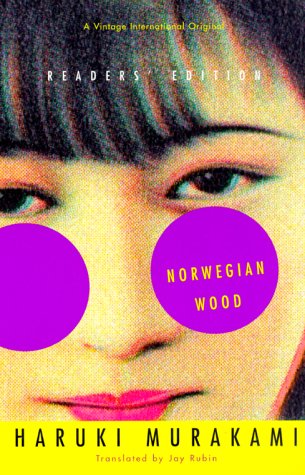April 2009:


Summary:
(From Barnes & Noble)This stunning and elegiac novel by the author of the internationally acclaimed Wind-Up Bird Chronicle has sold over 4 million copies in Japan and is now available to American audiences for the first time. It is sure to be a literary event.
Toru, a quiet and preternaturally serious young college student in Tokyo, is devoted to Naoko, a beautiful and introspective young woman, but their mutual passion is marked by the tragic death of their best friend years before. Toru begins to adapt to campus life and the loneliness and isolation he faces there, but Naoko finds the pressures and responsibilities of life unbearable. As she retreats further into her own world, Toru finds himself reaching out to others and drawn to a fiercely independent and sexually liberated young woman.
A poignant story of one college student's romantic coming-of-age, Norwegian Wood takes us to that distant place of a young man's first, hopeless, and heroic love.

About the author:
(From Barnes & Noble)The story of how Haruki Murakami decided to become a novelist says a lot about his work, because it is as strange and culturally diffuse as the works he writes. While watching a baseball game in Toyko in 1978 between the Yakult Swallows and the Hiroshima Carp, Murakami witnessed an American hit a double. At the crack of the bat, Murakami -- who had never had any ambition to write because he assumed he didn't have the talent -- decided that he should begin a novel. He then started his first book, in the night hours after work.
If you're waiting for a connection between the double and the epiphany, there isn't one. It's often that way in Murakami's fiction, where cultures blend and seemingly incongruous, inexplicable events move the story forward. People disappear or transform as quickly as the worlds around them, and the result is a dreamlike atmosphere that blends mystery, magic realism and sci-fi while remaining unmistakably distinct from all three.
Murakami was brought up in a suburb of Kobe by parents who were teachers of Japanese literature; but the literature of his parents did not interest him and he read mostly American authors, listened to American jazz and watched American shows. For this reason, though his books are set in Japan and originally written in Japanese, they do not seem terribly foreign to English speakers. South of the Border, West of the Sun's title derives from a Nat King Cole song; and you're as likely to find a reference to McDonald's, Cutty Sark or F. Scott Fitzgerald as you are to anything Japanese.
Murakami began his career with the coming-of-age novels Hear the Wind Sing and Pinball 1973, but he hit his stride with A Wild Sheep Chase, a novel about a twentysomething ad executive who is drawn into the quest for an elusive, mutant sheep. The novel appeared in the U.S. seven years after its 1982 publication, introducing American audiences to this unclassifiable author. It contained many of the traits that mark Murakami's novels: a solitary male protagonist who drifts just outside society; first-person narration; and philosophical passages nestled within outlandish, unconventional plots. An admiring New York Times Book Review called Murakami a "mythmaker for the millennium."
The author's commercial breakthrough in Japan had come with the publication of Norwegian Wood in 1987, which sold two million copies. The story of a man who becomes involved with his best friend's girlfriend after the friend's suicide, it stands alone as the author's most straightforward, realistic work. Murakami acknowledges the book's impact on his career, and stands behind it; but he is also aware that it represented a departure from the surreal books that had made him a "cult" author with a modest following. "After Norwegian Wood, I have not written any purely realistic novels," Murakami said in a 2001 publisher's interview, "and have no intention of writing any more at this time."
Murakami's return to surrealism with Dance Dance Dance (the sequel to A Wild Sheep Chase), however, did not slow his career growth. Further translations of his work and publication of his stories in the New Yorker assured a growing following in the States, where his best known (and, to some, his best) work is The Wind-Up Bird Chronicle, which appeared here in 1997. It's a masterful work that draws together all of the themes Murakami had been exploring in his fiction up until then: modern ennui, the unpredictability of relationships, a haunting backdrop of Japanese history.
In addition to his sublime and profoundly strange short stories and novels (Sputnik Sweetheart; Kafka on the Shore; Blind Willow, Sleeping Woman, etc.), Murakami has made occasional forays into nonfiction -- most notably with Underground, a compilation of interviews with victims of the 1995 sarin gas attack on the Tokyo subway, and his 2008 memoir of the New York City Marathon, What I Talk About When I Talk About Running. He has also translated several works by American authors into Japanese, including title by F. Scott Fitzgerald, Raymond Carver, and John Irving.
